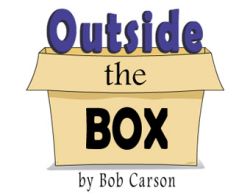Time-less Question
November 21, 2016,by Bob Carson
Editor’s Note: The USTA website is pleased to present freelance writer Bob Carson and his popular “Outside the Box” features. This monthly series is a menu of outlandish proposals presented with a wink — but the purpose behind them is serious. The views contained in this column are that of the author alone, and do not necessarily represent the opinions or views of the United States Trotting Association.

Bob Carson
It happened again.
For the third consecutive year, my outreach mission did not result in a convert to our harness racing flock. My recruit was a thirtyish fellow who had never seen a harness race. He agreed to join me for an evening at the harness track. As we waited for the trotters in the fifth race to step onto the track, my friend shared his early impressions of harness racing. He was unimpressed. His comments were annoyingly familiar.
“Well, the racing part is okay, but we have been here what, an hour and a half, two hours, and there have been four races. They race, they finish, and then we sit around for like, 20 minutes waiting for the next bugle and the parade. No offense, but that is sort of boring. What is with the wait between races?”
My answers were gibberish, and he knew it.
“Well, the sport depends on gambling and they need to allow time for people to place bets.”

He held up his phone. “Dude, you just showed me how you made your bets on your cell phone, it took like 15 seconds.”
“Well, people at the track need to line up at the windows.”
He pointed at the on-track betting windows where there were three people.
I said, “Well, people need time to study the program, handicap the race.”
“You told me that you can get the racing program early online. When you have it, you can study it on the bus or on your couch. What, is there some kind of big secret that says you need to like…cram for an exam in the last 15 minutes?”
“Well, some bettors like to watch the odds fluctuate and put their bet down at the last few seconds before the horses start the race.”
“If you bet on your computer you can wait until the last nano-second. What is the difference if there are five minutes between races or 20 minutes between races, the last few seconds are always going to be the last few seconds?”
I was going to toss out some nonsense about how all the people in the paddock had a great deal to do — but in my heart I knew that a lot of paddock time is spent sitting on an upside-down bucket listening to other grooms moan about how they have “One in the first and one in the last.”
Marcel Proust was onto something when he said that the inertia of our minds urges us to slide down the slope rather than to climb the steep slope of introspection. My pushback against my friend who complained of the long delay between races left me defending a situation that felt indefensible.
Everybody seems to want to get on with the show. So why do we have such a lag time between races? Why isn’t five minutes (or less) enough? Is it just the way it always has been? Is it a remnant from when bettors stood in queues in suits and wide brimmed hats grumbling about how slowly the line was moving? Why can’t an evening at the races or an evening following your favorite track on the computer last less than two hours from first race until the last?
Pardon the pun, but maybe it is time to pick up the pace for a population who panics when their I-pad drops a connection, or for whom instant gratification takes too long. Americans are not a patient lot, and languid is not a pace sweeping the nation in 2016.
Money and wagering patterns are, of course, very important. But maybe more rapid fire wagering would help. Slot machine players, poker players, virtually all other gambling entities do not dally. They get customers into a gambling groove and keep rolling. What if our glacial pace in horse racing gives gamblers too much time to think? What if our pace dilutes the rush that can fuel gambling?
Changing positions is difficult, astonishingly difficult. Many people choose a political party and will vote for a monkey perched on a bicycle as long as the monkey has an R or a D on their back. Every argument, every scrap of knowledge is framed by the original, comfortable position. We are all guilty of this to some degree. This also happens in our sport.
Let us assume that you have been a fan for 30 or 40 years. How many times in the last decade have you attended your racetrack before the first race and stayed until the last race on the program? How many times have you logged onto your computer and remain transfixed to your favorite track for the entire program? How many of you can honestly say you are glued to your seat or excited for a four hour race program?
Isn’t it possible that if your harness race evening was compressed to less than two hours that your interest and wagering might be rejuvenated?
